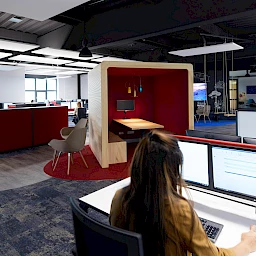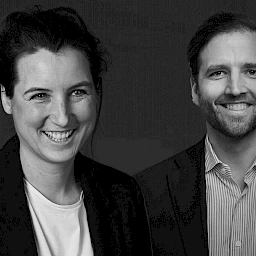At the IBA Forum on 27 January 2022, Dr Katharina Radermacher shared her insights into the relationships between workstation design, workplace atmosphere and employees’ willingness to recommend their employers. Dr Radermacher, an academic councillor at the professorial chair for human resources management at Paderborn University, gave this talk to mark the publication of her study of findings regarding employees’ assessments of their employers. Her informative talk is available as a video in the media library. In the following text we’ve summarized the key messages of the talk and the study for you.
For the study, Dr Katharina Radermacher and her colleague Enja Marie Herdejürgen evaluated data that had been gathered in connection with the Best Workplace Award 2019 by the employer assessment platform kununu and the IBA. The 13,033 data sets comprise data regarding the traditional aspects of employers’ attractiveness, as well as additional assessments of workstation design. To supplement this material, they also analysed 1,788 comments that were randomly selected from 44,000 free-text evaluations submitted to kununu in 2019.
Please also read

Employee recommendations as a recruitment tool
The starting point of the researchers’ observations is the significance of employees’ recommendations of companies. According to the researchers, not only employees’ personal recommendations to friends and acquaintances but also their evaluations on employer assessment platforms are a central source of information for job applicants. Companies benefit from positive recommendations, and during the pre-hire phase this results in a more efficient recruitment process, an improvement in the quality of job applications and a better match with the pool of applicants. During the post-hire phase, the new employees are more satisfied with their work and they stay in the workforce longer if their hiring was preceded by employees’ recommendations. However, in the authors’ opinion, companies in Germany have paid far too little attention to the findings of employer assessment platforms to date.
We know that recommendations can make the recruitment process more efficient because they provide much more realistic and detailed information than do career websites and job advertisements. Thanks to the detailed information, job applicants can make a much better judgment of whether they fit a specific company, and then decide on that basis whether they want to continue or end the application process.
Dr Katharina Radermacher

Soft factors play a key role in the willingness to recommend employers
Traditional job aspects such as salary, work-life balance, job security and advanced training options have long been relevant to recruitment success. However, their influence on an employer’s appeal, employee satisfaction and the rate of recommendations is not as strong as people often assume.
In fact, the biggest influence on employees’ willingness to recommend an employer is exerted by “soft factors”— above all, the workplace atmosphere, followed by the managers’ behaviour and internal communication. Workstation design and workstation characteristics also have an influence on employees’ willingness to recommend an employer. Flexible working times and the opportunity to use diverse work areas within the company are especially important characteristics here. In addition, the analysis of the evaluated data showed that the opportunity to use differently equipped spaces also improves the quality of communication within the companies.
By contrast, the question of whether small spatial units were available for concentrated desk work or, alternatively, whether people worked in open-plan spaces did not have any influence on employees’ willingness to recommend an employer. The same is true of the intensity and the quality of communication with colleagues.
The study’s three main findings:
-
Employees’ willingness to recommend employers can be influenced in particular by soft factors such as the workplace atmosphere, managers’ behaviour and communication inside the company.
-
Workstation characteristics, flexible work times above all and the flexible use of work areas indicate a previously ignored potential for the generation of recommendations.
-
In order to create a positive perception of the workplace atmosphere, cohesion between colleagues should be reinforced and physical and emotional pressures should be avoided.
The central factor: the workplace atmosphere
Keeping in mind the strong significance of the workplace atmosphere for employees’ willingness to recommend employers, the two authors conclude by dealing with the question of which influencing factors determine the workplace atmosphere. For this purpose they used the evaluations posted at kununu in 2019.
They found that whether or not the workplace atmosphere is perceived as positive by employees essentially depends on the cohesion between colleagues — on the experience of colleagues’ helpfulness, teamwork, collaboration, friendliness and openness. Employees’ positive impression of the workplace atmosphere is reinforced by good managers who respond to the employees’ needs and by an emotional connection with the company and its corporate culture.
Here too, the design of the office spaces has a significant positive effect that is roughly equal to the influence of modern office organization.
As companies develop new workstation concepts, they should focus very clearly on the workplace atmosphere. One way to do this is to promote a sense of cohesion among colleagues. Companies can set their course in this direction by literally bringing their employees together by means of workstation design and working concepts. That includes common areas as well as shared routes and work times. Equipment areas suitable for flexible use are also necessary.
Dr Katharina Radermacher

The study’s findings document the fact that employees want to work autonomously in an environment that fosters cooperation and supports employees’ diverse requirements. The two authors’ evaluation is that the potentials of workstation design and the findings of employer assessment platforms have not received nearly enough attention from companies to date.





